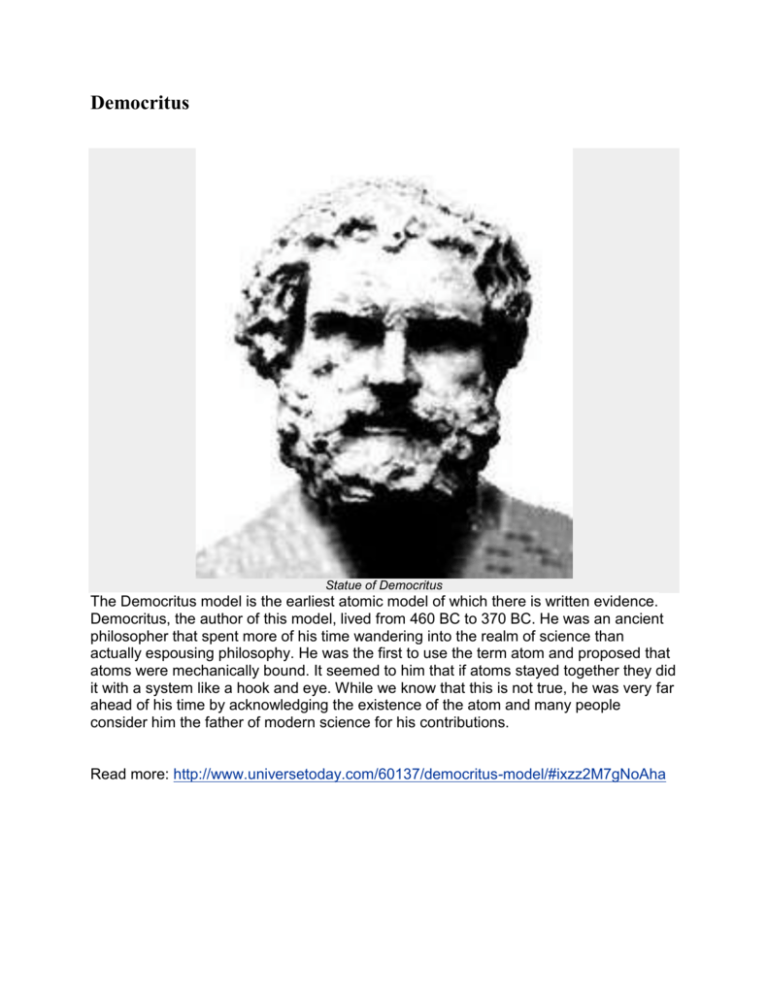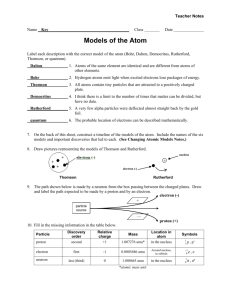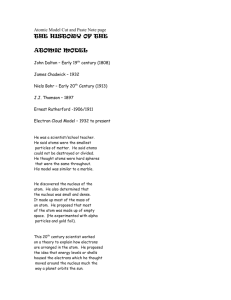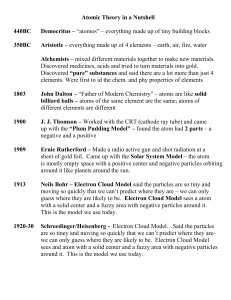Democritus
advertisement

Democritus Statue of Democritus The Democritus model is the earliest atomic model of which there is written evidence. Democritus, the author of this model, lived from 460 BC to 370 BC. He was an ancient philosopher that spent more of his time wandering into the realm of science than actually espousing philosophy. He was the first to use the term atom and proposed that atoms were mechanically bound. It seemed to him that if atoms stayed together they did it with a system like a hook and eye. While we know that this is not true, he was very far ahead of his time by acknowledging the existence of the atom and many people consider him the father of modern science for his contributions. Read more: http://www.universetoday.com/60137/democritus-model/#ixzz2M7gNoAha Dalton It was John Dalton, in the early 1800's, who determined that each chemical element is composed of a unique type of atom, and that the atoms differed by their masses. He devised a system of chemical symbols and, having ascertained the relative weights of atoms, arranged them into a table. In addition, he formulated the theory that a chemical combination of different elements occurs in simple numerical ratios by weight, which led to the development of the laws of definite and multiple proportions. He then determined that compounds are made of molecules, and that molecules are composed of atoms in definite proportions. Thus, atoms determine the composition of matter, and compounds can be broken down into their individual elements. http://abyss.uoregon.edu/~js/21st_century_science/lectures/lec05.html JJ Thomson The Early Days by Anthony Carpi, Ph.D. Until the final years of the nineteenth century, the accepted model of the atom resembled that of a billiard ball - a small, solid sphere. In 1897, J. J. Thomson dramatically changed the modern view of the atom with his discovery of the electron. Thomson's work suggested that the atom was not an "indivisible" particle as John Dalton had suggested but, a jigsaw puzzle made of smaller pieces. Thomson's notion of the electron came from his work with a nineteenth century scientific curiosity: the cathode ray tube. For years scientists had known that if an electric current was passed through a vacuum tube, a stream of glowing material could be seen; however, no one could explain why. Thomson found that the mysterious glowing stream would bend toward a positively charged electric plate. Thomson theorized, and was later proven correct, that the stream was in fact made up of small particles, pieces of atoms that carried a negative charge. These particles were later named electrons. http://www.visionlearning.com/library/module_viewer.php?mid=50 Rutherford Rutherford performed a series of experiments with radioactive alpha particles. While it was unclear at the time what the alpha particle was, it was known to be very tiny. Rutherford fired tiny alpha particles at solid objects such as gold foil. He found that while most of the alpha particles passed right through the gold foil, a small number of alpha particles passed through at an angle (as if they had bumped up against something) and some bounced straight back like a tennis ball hitting a wall. Rutherford's experiments suggested that gold foil, and matter in general, had holes in it! These holes allowed most of the alpha particles to pass directly through, while a small number ricocheted off or bounced straight back because they hit a solid object. In 1911, Rutherford proposed a revolutionary view of the atom. He suggested that the atom consisted of a small, dense core of positively charged particles in the center (or nucleus) of the atom, surrounded by a swirling ring of electrons. The nucleus was so dense that the alpha particles would bounce off of it, but the electrons were so tiny, and spread out at such great distances, that the alpha particles would pass right through this area of the atom. Rutherford's atom resembled a tiny solar system with the positively charged nucleus always at the center and the electrons revolving around the nucleus. The positively charged particles in the nucleus of the atom were called protons. Protons carry an equal, but opposite, charge to electrons, but protons are much larger and heavier than electrons. http://www.visionlearning.com/library/module_viewer.php?mid=50 Bohr While the Rutherford model focused on describing the nucleus, Niels Bohr turned his attention to describing the electron. Prior to the Bohr Model, the accepted model was one which depicted the electron as an orbiting planet. The flaw with the planet-like model is that an electron particle moving in a circular path would be accelerating (see circular motion). An accelerating electron creates a changing magnetic field. This changing magnetic field would carry energy away from the electron, eventually slowing it down and allowing it to be "captured" by the nucleus. Bohr built upon spectroscopic observations of atoms. Spectroscopists noticed that an atom can only absorb certain energies (colors) of light (the absorption spectrum) and once excited can only release certain energies (the emission spectrum) and these energies happen to be the same. Bohr used these observations to argue that the energy of a bound electron is "quantized." Quantized is a fancy word meaning only certain quantities of energy are allowed. http://www.regentsprep.org/regents/physics/phys05/catomodel/bohr.htm Electron Cloud Model (Quantum Mechanical Model) Erwin Schrödinger built upon the thoughts of Bohr yet took them in a new direction. He developed the probability function for the Hydrogen atom (and a few others). The probability function basically describes a cloud-like region where the electron is likely to be found. It can not say with any certainty, where the electron actually is at any point in time, yet can describe where it ought to be. Clarity through fuzziness, is one way to describe the idea. The model based on this probability equation can best be described as the cloud model. The cloud model represents a sort of history of where the electron has probably been and where it is likely to be going. The red dot in the middle represents the nucleus while the red dot around the outside represents an instance of the electron. Imagine, as the electron moves it leaves a trace of where it was. This collection of traces quickly begins to resemble a cloud. The probable locations of the electron predicted by Schrödinger's equation happen to coincide with the locations specified in Bohr's model. http://www.regentsprep.org/regents/physics/phys05/catomodel/cloud.htm






